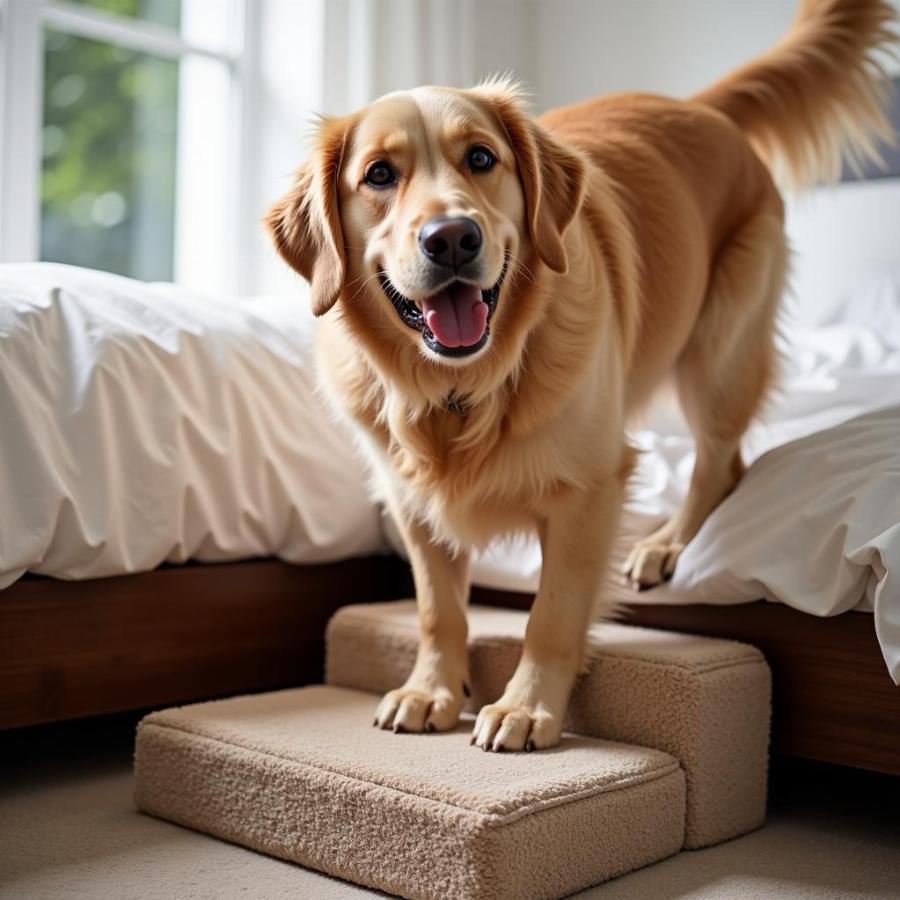Is your furry friend struggling to hop onto your bed? As our dogs age or face mobility challenges, those once effortless leaps can become difficult and even dangerous. Enter dog stairs for beds, a practical and adorable solution to keep your pup safe and comfortable. In this comprehensive guide, we’ll delve into everything you need to know about dog stairs, from choosing the right size to ensuring their stability and your dog’s confidence.
Why Consider Dog Stairs for Your Bed?
While some might see dog stairs as a luxury, they can be a true necessity for many dogs. Here’s why:
- Joint Health: Jumping on and off high beds can put significant stress on your dog’s joints, especially breeds prone to hip dysplasia or arthritis. Dog stairs minimize impact and reduce the risk of injuries.
- Accessibility: Senior dogs, puppies, and those with medical conditions often struggle with heights. Dog stairs provide them with easy and independent access to their favorite sleeping spot – right next to you.
- Preventing Accidents: A clumsy fall can lead to sprains, strains, or even more serious injuries. Dog stairs offer a controlled and secure way for your pup to get on and off the bed, reducing the likelihood of accidents.
Choosing the Right Dog Stairs
Selecting the perfect set of stairs for your furry friend involves considering their specific needs and your bed’s height.
Measuring Up for Success
- Height: Measure the distance from the floor to the top of your bed. Choose stairs that are slightly shorter than this measurement to ensure a comfortable incline.
- Dog’s Size: Consider your dog’s breed, weight, and length. Larger dogs will require wider and sturdier stairs.
Types of Dog Stairs
- Ramp Stairs: Ideal for older dogs or those with mobility issues, offering a gentle slope.
- Traditional Stairs: Provide better support and stability, suitable for most dogs.
- Folding Stairs: Perfect for space-saving and portability.
Key Features to Consider
- Stability: Opt for stairs with a wide base and non-slip feet to prevent wobbling or tipping.
- Surface: Choose stairs with a carpeted or textured surface to provide traction and prevent slipping.
- Material: Durable materials like wood, metal, or high-quality plastic are ideal for long-lasting use.
Introducing Your Dog to Their New Stairs
Patience and positive reinforcement are key to helping your dog become comfortable using their new stairs.
- Start Slowly: Place the stairs in a familiar area and allow your dog to investigate them at their own pace. Reward them with treats and praise for showing interest.
- Lure and Reward: Use treats or toys to encourage your dog to climb up and down the stairs. Gradually increase the distance they climb as they gain confidence.
- Make it Fun: Turn stair climbing into a game by tossing toys up and down the steps.
- Be Patient: Some dogs take to stairs immediately, while others require more time and encouragement. Stay positive and avoid forcing your dog to use the stairs.
 Dog Confidently Using Stairs
Dog Confidently Using Stairs
Safety First: Using Dog Stairs Safely
- Supervision: Initially, supervise your dog while they use the stairs, especially if they are a puppy or senior.
- Placement: Position the stairs on a level surface, away from obstacles or hazards.
- Maintenance: Regularly check the stairs for any damage or loose parts.
FAQs: Common Questions About Dog Stairs
Q: Are dog stairs only for older dogs?
A: While particularly beneficial for senior dogs, stairs can be helpful for dogs of all ages, especially those prone to joint issues or those recovering from surgery.
Q: How do I choose the right height stairs for my dog?
A: Measure the distance from the floor to your bed and choose stairs slightly shorter than that measurement.
Q: What if my dog is afraid of the stairs?
A: Start with short sessions, using treats and praise to encourage them. If they remain fearful, consult a certified dog trainer for guidance.
Need More Help?
At Beaut Dogs, we’re passionate about providing you with the information you need to give your furry friends the best possible care. For more helpful tips on dog health, training, and well-being, visit us at https://beautdogs.com. If you have specific questions or need personalized advice, don’t hesitate to contact us at [email protected]. We’re here to help you and your beloved canine companion live a happy, healthy life together.